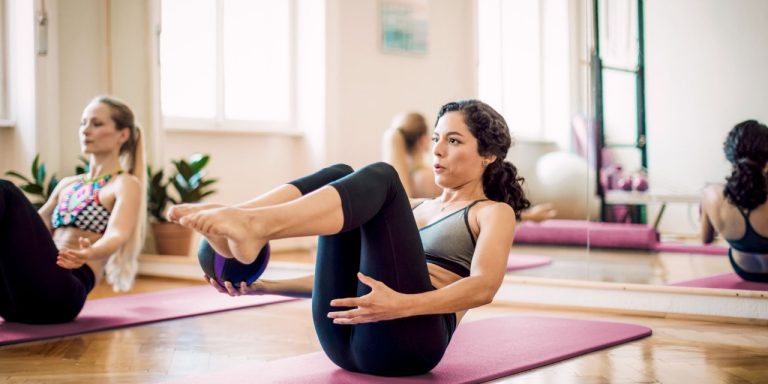Postnatal course
From gymnastics to yoga: there are plenty of postnatal courses on offer. All the courses aim to rebuild strength in your core and pelvic floor. Find out which course is best for you and which services Helsana covers.

How does postnatal gymnastics help?
Pregnancy and childbirth place great strain on and stretch your pelvic floor muscles. Postnatal gymnastics is therefore mainly about rebuilding your core strength. The pelvic floor is important in several ways. It supports your internal organs and enables you to stand upright. A strong pelvic floor is also important for keeping the sphincter muscles of your bladder and gut working properly.
You can start doing postnatal gymnastics around six to eight weeks after your baby is born. If you’ve had a caesarean section, you should wait for up to ten weeks. Ideally, you should try to do the postnatal exercises two to three times a week. There are also some quick exercises that you can do in between, like when waiting for the bus. An example: Tense all the muscles in your lower abdomen at the same time. Count to six and relax your muscles again.
Abdominal separation: when your abdominal muscles make way
During your pregnancy, the muscles running down your abdomen move sideways to make room for your growing baby and expanding womb. This is also known as abdominal separation. After the birth, you may notice a gap in the middle of your belly. Often, the abdominal walls go back to normal by themselves after a while. If not, you’ll need to get treatment. Talk to your midwife or specialist carer about this in the postnatal period.
What kinds of postnatal courses are there?
There is a huge variety of postnatal exercises. In the courses, you will do strengthening exercises and learn interesting background knowledge about postnatal recovery. The courses also give you an opportunity to ask questions and talk to other mothers.
Our postnatal recovery services
Under COMPLETA supplementary insurance, you will receive 75% of the costs up to CHF 500 per calendar year for pregnancy-related courses, e.g. postnatal and pelvic floor training.
Traditional postnatal gymnastics
In postnatal gymnastics, you’ll do different strengthening exercises for your abdomen, back and leg muscles. The courses also involve various relaxation, stretching and breathing exercises. This will help you reconnect with your body. There is often a short one-off session where you can bring your newborn along. The course instructor will show you how to do the exercises with your child, helping you incorporate them into your everyday routine in a fun way.
Postnatal yoga
Yoga promotes inner peace and balance. The various exercises strengthen your body and improve your flexibility. In postnatal yoga, you will focus on strengthening your pelvic floor, back and abdominal muscles. The exercises also help ease tension in your body.
Postnatal Pilates
Pilates aims to harmonise and train both the body and mind. Pilates is all about your core. Targeted exercises strengthen and tighten the muscles and ligaments in your abdomen.
What’s the difference between Pilates and yoga?
The major difference between Pilates and yoga is breathing technique. In Pilates, you breathe in through the nose and out through the mouth. In yoga, however, you only breathe through the nose. Breathing also plays a more significant role in yoga exercises.
Pelvic floor exercises at home
Postnatal courses offer many benefits. The course instructor can give you personal support and correct your posture when doing the exercises. Training with others is more motivating, and it’s good to talk to like-minded people. However, you can also train your pelvic floor any time on your own at home, or do the exercises alongside a course.
Postnatal course with or without baby?
You can do your postnatal course with or without your baby, depending on the course. With postnatal gymnastics, it’s sometimes not that easy to involve your baby in the exercises. Pelvic floor exercises and relaxation techniques aren’t always suited to this. By doing the course without your baby, you’ll get a chance to focus completely on yourself. It’ll also avoid distractions for you or the others in the course. Some courses offer a free childcare service. This depends on the organiser.
Do you have questions?
We're here to help.